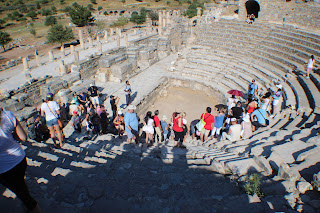The sunset over the Aegean Sea was beautiful. A nice way to end the day in a cool pool outside the Hotel on a very balmy evening.
Today we head for Ephesus. We start early as Ephesus is apparently always crowded with tourist in summer. Ephesus is the best ancient city in Turkey.
We headed of early. On the bus at 8.00am. After a short drive we arrive at the gates of Ephesus.
Lots of hawkers trying to sell you things from genuine fake watches to ancient coins (if you can call last day's run as ancient) to selling you hats, food or water.
Ephesus was an ancient Greek city, and later a major Roman city, on the coast of Ionia, near present-day Selçuk, Izmir Province, Turkey. It was one of the twelve cities of the Ionian League during the Classical Greek era.
From Ephesus we headed for the city of Smyrna. Smyrna (Ancient Greek: Σμύρνη or Σμύρνα) was an ancient city located at a central and strategic point on the Aegean coast of Anatolia. Due to its advantageous port conditions, its ease of defence and its good inland connections, Smyrna rose to prominence. The ancient city is located at two sites within modern İzmir, Turkey. The first site, probably founded indigenously, rose to prominence during the Archaic Period as one of the principal ancient Greek settlements in western Anatolia. The second, whose foundation is associated with Alexander the Great, reached metropolitan proportions during the period of the Roman Empire. Most of the present-day remains date from the Roman era, the majority from after a 2nd-century AD earthquake.
Today we head for Ephesus. We start early as Ephesus is apparently always crowded with tourist in summer. Ephesus is the best ancient city in Turkey.
We headed of early. On the bus at 8.00am. After a short drive we arrive at the gates of Ephesus.
Lots of hawkers trying to sell you things from genuine fake watches to ancient coins (if you can call last day's run as ancient) to selling you hats, food or water.
Ephesus was an ancient Greek city, and later a major Roman city, on the coast of Ionia, near present-day Selçuk, Izmir Province, Turkey. It was one of the twelve cities of the Ionian League during the Classical Greek era.
The streets in Ephesus were marble. It also boasted the Library of Celsus with 12 000 books, (The third largest library in the ancient world,) plus your obligatory temple of Artemis (what's left of it anyway). The toilets were also impressive.
In Ephesus we also visited the Basilica of St John. It was constructed by Justinian I in the 6th century. It stands over the believed burial site of St
John the Apostle. It was modeled after the now lost Church of the Holy Apostles in Constantinople.
 |
| Magic Sunset over the Hotel pool |
 |
| On the way to Ephesus |
 |
| Entrance to Ephesus |
 |
| Ephesus Street |
 |
| Parliament for Ephesians |
 |
| Street in Ephesus |
 |
| goddess Nike |
 |
| Looking down the street towards the Library |
 |
| Another Street Scene |
 |
| The Library of Celsus |
 |
| Entrance to the Latrine |
 |
| Entrance to one of the homes |
 |
| Water room |
 |
| Bedrooms |
 |
| More bedrooms |
 |
| Closer look at the libary |
 |
| Having a rest |
 |
| Ephesus street under excavation |
 |
| Statue on the Library |
 |
| Looking Up in the Libary |
 |
| Looking out from the Library to the street |
 |
| Austrian archeologists digging for ancient treasure |
 |
| St John's Basilica in Ephesus |
 |
| Inside the Basilica |
 |
| Mum and kids or was it dad the kid.. |
 |
| Inside St Johns |
 |
| Shroud of Turin |
 |
| Inside Polycarp's Church |
 |
| A commercial Agora (market place) |
 |
| Under the Agora - became a church |
 |
| Statues in ancient Ephesus |
 |
| Temple of Artemis |
In Smyrna we visited the ancient Agora ( or commercial markets.) The city of Smyrna is mentioned in Revelation 2.8. The Agora was converted to a Basilica. While in Smyrna we also visited the church of Polycarp. Polycarp was a 2nd-century Christian bishop of Smyrna. According to the Martyrdom of Polycarp he died a martyr, bound and burned at the stake, then stabbed when the fire failed to touch him. Quite a determined character if the story is true.
From Smyrna we headed to Pergamon, where we are staying overnight. Another day over. Again we ended up in a very cool large blue water pool at the end of the day.
No comments:
Post a Comment